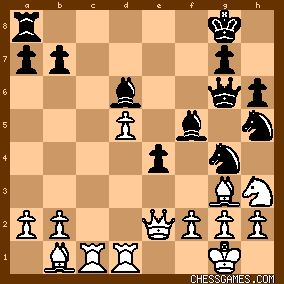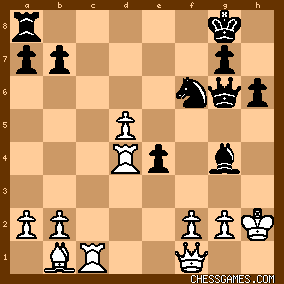Apr-30-05
 | | Sneaky: I don't agree with Blackburne when he says about the central variation 3.e4 "Not often played, and inferior to the usual ♘f3." However, Steinitz went astray as early as 4.d5. This is not a good idea. The newer, better idea is 4.♘f3 and if 4...exd4 you don't take on d4 but instead 5.♗xc4 and worry about the d-pawn later. I find it these lines lead to imbalanced lively positions that slightly favor the first player. But don't get the wrong idea, of course I don't criticize either of these immortal players for not knowing about modern theory. |
|
| Apr-30-05 | | WorldChampeen: How about this <Sneaky> I think 4. d5 is okay, 4. ...Nf6 (correct) 5. Nc3 (correct) and then, now 5. ...Bb4 to pin the knight can not be played because of 6. Qa4+! that is why 5. ...Bc5 by Blackburne. |
|
Apr-30-05
 | | Sneaky: You are right 5...Bb4 is impossible on account of Qa4+, but ...Bc5 is a very good move in that position. In fact according to the Opening Explorer, Black has never lost with it! (out of 3 games.) |
|
| Apr-30-05 | | WorldChampeen: <Sneaky> I don't doubt your word, I do have Glenn Flear's book on countless games of the QGA shall we say, Look this is when you want the d5 move,
1. d4 d5 2. c4 dxc 3. Nc3 Nc6 and then, one needs to be careful about the Queen or Knight taking the pawn on d4 so then, 4. d5 is needed... |
|
| May-05-05 | | WorldChampeen: 1620, 1.d4 d5 2.c4 dxc4 3.e3 b5 4.a4 c6 5.axb5 cxb5 6.Qf3 1-0 ~ Greco vs NN, 1620 You know, you can catch people on this trap, but 3. e3, I'd much rather do 3. e4 and for a long time, I was playing 3. Nc3 and doing okay; but that is not a very popular choice. Check this little trap of El Greco. And the thing is, I might have played this before but may not have realized 6. Qf3; it's kind of an unfair advantage and 3. e3 is playable but not the best move. M. Yudovich is whom I credit with showing me this. It's almost unfair but I guarantee you; a lot of people will go for it. Amazing, from 1620 and I think, this reflects the wisdom of not trying to hold on to the pawn. Hey <Sneaky> there's that a4 move! |
|
| Dec-16-05 | | Frankly: Wow, tremendous game, And I was just checking up the 4d5 line! |
|
| Apr-26-06 | | netlava: 4. d5 reduces the scope of white's light squared bishop. But other than that, I don't see anything wrong with it. What else is wrong with 4. d5? Also I think 3. e4 is inferior but I'm not sure how. lol |
|
| Apr-07-07 | | Knight13: Based on this game I think ...Bc5 works better than ...c6. |
|
| Jan-08-08 | | sneaky pete: The losing move 26.d6? .. is conveniently ignored in Blackburne's notes. After 26.Rc3 .. (so as to be able to play Qf1-c1-f4 if necessary) it's not clear how black can save the game. |
|
Jan-09-08
 | | Pawn and Two: 25...Nf6?? was a serious error.
Blackburne should have taken the draw with: (.00) (23 ply) 25...Nf4 26.f3 Qh5+ 27.Kg1 Bxf3 28.gxf3 Qh4 29.Rc2 Nh3+ 30.Kg2 Nf3+ 31.Kg1. Steinitz then returned the favor with 26.d6??.
Instead, he had at least 2 lines that offered very good winning chances: (2.21) (21 ply) 26.Kg1 Qh5 27.Qe1 Bd7 28.Rc7 Qe5 29.Rdc4 Bc6 30.R7xc6 bxc6 31.dxc6, or, (1.95) (21 ply) 26.Qe1 Re8 27.Qe3 Bf5 28.Kg1 Ng4 29.Qf4 Qf6 30.Rb4 g5 31.Qg3. Not as good was: (1.13) (21 ply) 26.Rc3 Qh5+ 27.Kg1 Bf3 28.Qc1 Ng4 29.Rc8+ Kh7 30.Bxe4+ Bxe4 31.Rxe4 Qf5 32.Rxg4+ Rxc8, and Black can still offer strong resistance. |
|
Jan-14-17
 | | KEG: Steinitz' 3. e4 is probably not as good as the usual 3. Nf3, but it's not bad. 3. e3 is also good. Steinitz' 4. d5, however, was poor. White should be pressuring Black's pawn at e5 ASAP. Moreover, Blackburne could have simply played 4...b5 (which Fritz thinks is by far the best response to 4. d5 and gives Black a significant edge). This looks ugly to me, but Black does seem to emerge with the better game in all lines I can find. After Blackburne's 4...Nf6, Steinitz needed to play 5. Qc2. After his actual 5. Nc3, 5...b5 would have been strong for Blackburne. Of course, the opening issues here were only appetizers for the fascinating struggle that ensued between these two veteran chess titans. |
|
Jan-14-17
 | | KEG: This game contains lots of thrilling tactics, but also many errors and oversights, the most serious of which have long since been identified on this site by sneaky pete and pawn and move. Blackburne decided to attack at all costs. This aggressive instinct is what gives the game its exciting character, but the failure of Blackburne and the Tournament Book to point out the errors is troubling. The game after Steinitz' 7. Nh3 was about even. But Blackburne's wild 7...f5 allowed Steinitz' powerful 8. Bg5, after which he had what appears to be (and what Fritz rates as) a clearly winning position. Steinitz then missed several opportunities to solidify his winning position, and erred seriously on his 9th, 11th, 12th, and 13th moves. The first key moment of the game came when Blackburne sacrificed material with 14...0-0. Steinitz accepted the challenge and played 15. Nxc7 (far better than the silly 15. NxB suggested by Hoffer in the Tournament Book, which would have flipped the edge to Blackburne). Blackburne now needed to play 15...Rac8 (and not 15...Ndf6 as proposed by both Blackburne and the Tournament Book). His actual move, 15...Nb6, removing a key attacking piece from the battle scene on the King's side at the very moment he was sacrificing the exchange, was a serious error. Even worse, after Steinitz took his Rook with 16. NxR, Blackburne played the simply horrible 16...RxN (moving his Rook to the wrong side of the board) instead of the clearly indicated 16...NxB. Blackburne was now dead lost, and his follow-up move 17...Nd7 only made matters worse. Fritz now rates Steinitz' edge as (3.43). Even after Steinitz' weak 19. Bd3, he still had the game well in hand when he confronted the following position on his 21st move: 
click for larger viewAs both the Tournament Book and Blackburne have noted, 21. Rc3 would have foiled Blackburne's intended combination. (21. Re1 would also have done the trick). Instead, Steinitz played 21. Qb5, allowing Blackburne's pretty 21...Nxh2. Blackburne claims that Steinitz was now lost. While 21...Nxh2 was pretty, Blackburne's claim is simply wrong. Indeed, Steinitz still had a won game. His fatal blunder came later. The Tournament Book claims that "22. Rc3 would still have saved the game." In fact, Steinitz' 22. BxN was just fine. He still had a won game through Blackburne's 24...Bg4. Here, 25. d6 (a move Steinitz played one move too late) would still have preserved Steinitz' win. But he erred with 25. Rd4. Now, as Pawn and Move noted on this site years ago, Blackburne had a draw with 25...Nf4. But Blackburne here played 25...Nf6,which proved to be a "winning blunder." The position with Steinitz to make his 26th move was as follows: 
click for larger viewThe Tournament Book says that Steinitz could here have saved the game with 26. Rc3. As sneaky Pete and Pawn and move have long since discovered, 26. Rc3 doesn't just "save the game," it wins for White! Moreover, and as Pawn and Move has also discovered--and as I have confirmed with Fritz-- even better for White would have been 26. Kg1. Indeed, 26. Qe1 also wins here for White. But Steinitz here played 26. d6??, and got wiped out by Blackburne's 26. Qh5+ 27. Kg1 Be2 !!! (a truly beautiful move). I am astonished (and not a little bit troubled) that Blackburne did not mention what happened at the end of the game in his notes in which he wrongly suggested that the game was won for him after his 21...Nxh2. I am happy to see this this poor analysis by Blackburne has been refuted by those who frequent this site. |
|
|
|
|





